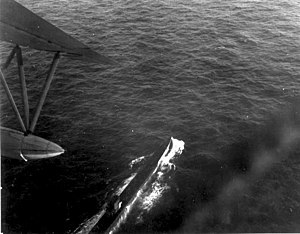|
German submarine U-199
German submarine U-199 was a Type IXD2 U-boat of Nazi Germany's Kriegsmarine during World War II. The submarine was laid down on 10 October 1941 at the DeSchiMAG AG Weser yard at Bremen as yard number 1045, launched on 11 July 1942 and commissioned on 28 November. She was commanded by Ritterkreuz recipient Kapitänleutnant Hans-Werner Kraus, who had previously successfully commanded U-47 and U-83. After training with the 4th U-boat Flotilla at Stettin, U-199 was transferred to the 12th U-boat Flotilla for front-line service from 1 May 1943.[1] She was sunk off the Brazilian coast on 31 July 1943 by the Brazilian Air Force Consolidated PBY Catalina flying boat "Arará". DesignGerman Type IXD2 submarines were considerably larger than the original Type IXs. U-199 had a displacement of 1,610 tonnes (1,580 long tons) when at the surface and 1,799 tonnes (1,771 long tons) while submerged.[3] The U-boat had a total length of 87.58 m (287 ft 4 in), a pressure hull length of 68.50 m (224 ft 9 in), a beam of 7.50 m (24 ft 7 in), a height of 10.20 m (33 ft 6 in), and a draught of 5.35 m (17 ft 7 in). The submarine was powered by two MAN M 9 V 40/46 supercharged four-stroke, nine-cylinder diesel engines plus two MWM RS34.5S six-cylinder four-stroke diesel engines for cruising, producing a total of 9,000 metric horsepower (6,620 kW; 8,880 shp) for use while surfaced, two Siemens-Schuckert 2 GU 345/34 double-acting electric motors producing a total of 1,000 shaft horsepower (1,010 PS; 750 kW) for use while submerged. She had two shafts and two 1.85 m (6 ft) propellers. The boat was capable of operating at depths of up to 200 metres (660 ft).[3] The submarine had a maximum surface speed of 20.8 knots (38.5 km/h; 23.9 mph) and a maximum submerged speed of 6.9 knots (12.8 km/h; 7.9 mph).[3] When submerged, the boat could operate for 121 nautical miles (224 km; 139 mi) at 2 knots (3.7 km/h; 2.3 mph); when surfaced, she could travel 12,750 nautical miles (23,610 km; 14,670 mi) at 10 knots (19 km/h; 12 mph). U-199 was fitted with six 53.3 cm (21 in) torpedo tubes (four fitted at the bow and two at the stern), 24 torpedoes, one 10.5 cm (4.13 in) SK C/32 naval gun, 150 rounds, and a 3.7 cm (1.5 in) SK C/30 with 2,575 rounds as well as two 2 cm (0.79 in) C/30 anti-aircraft guns with 8,100 rounds. The boat had a complement of fifty-five.[3] Operational historyU-199 sailed from Kiel on 13 May 1943 on her first and only operational patrol;[4] she negotiated the gap between Iceland and the Faroe Islands, before heading south and had crossed the Equator by 17 June, targeting ships in the South Atlantic Ocean. Operating off the Brazilian coast, she torpedoed and damaged the Brazilian armed merchant ship Bury, which returned fire and managed to escape. On 4 July, the submarine was spotted on the surface by the small fishing boat Changri-Lá.[5] The Brazilian boat was sunk with the loss of all hands by gunfire. U-199 had her first and only significant success, sinking the British merchant ship Henzada on 25 July.[6] FateU-199 was found on the surface, off Rio de Janeiro, in position 23°54′S 42°54′W / 23.900°S 42.900°W, by three aircraft, a PBY Catalina, a Lockheed Hudson (both Brazilian), and an American Martin PBM Mariner of VP-74 on 31 July.[1] The Catalina, codenamed Arará, hit U-199 with depth charges, sinking her. The pilot of the Catalina was 2º Ten.-Av. (2nd Lt.) Alberto M. Torres,[7] who later went to Italy as part of 1st Brazilian Fighter Squadron. Forty-nine of the crew were killed, although twelve Germans managed to escape including the captain. This was possible due to the actions of the Catalina's crew, who threw a lifeboat to the survivors. They were rescued by the USS Barnegat and taken to Brazil, and then on to captivity in the United States. Summary of raiding history
References
Bibliography
External links
|
|||||||||||||||||||||||||||||||||||||||||||||||||||||||||||||||||||||||||||||
Portal di Ensiklopedia Dunia
